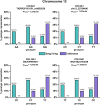Identification of genes associated with longevity in dogs: 9 candidate genes described in Cavalier King Charles Spaniel
- PMID: 39823074
- PMCID: PMC11737349
- DOI: 10.1016/j.vas.2024.100420
Identification of genes associated with longevity in dogs: 9 candidate genes described in Cavalier King Charles Spaniel
Abstract
In the past years, dogs have served as a convenient natural model organism for longevity due to their similarity with humans concerning not only their environment but also the diseases and complications occurring in older age. Since many dog breeds have significantly shorter lifespan than their closely related breeds, identification of genes associated with longevity may help to elucidate its background and serve as a possible tool for selective breeding of long-living dogs. This genome-wide association study (GWAS) was undertaken to identify the candidate genes associated with longevity in Cavalier King Charles Spaniel individuals that have reached the age of more than 13 years. We described 15 SNPs localized in nine genes: B3GALNT1, NLRP1 like, PARP14, IQCJ-SCHIP1, COL9A1, COL19A1, SDHAF4, B3GAT2, and DIRC2 that are associated with longevity in purebred Cavalier King Charles Spaniels. These results are promising for future research and possible selective breeding of companion dogs with extended lifespan.
Keywords: Cavalier King Charles Spaniel dog; Extending lifespan; GWAS; Longevity testing; Longevity-associated genes.
© 2024 The Authors. Published by Elsevier Ltd.
Conflict of interest statement
The authors declare that they have no known competing financial interests or personal relationships that could have appeared to influence the work reported in this paper.
Figures







Similar articles
-
Urine concentrations of xanthine, hypoxanthine and uric acid in UK Cavalier King Charles spaniels.J Small Anim Pract. 2013 Aug;54(8):395-8. doi: 10.1111/jsap.12106. Epub 2013 Jul 13. J Small Anim Pract. 2013. PMID: 23859747
-
Chiari-like malformation and syringomyelia in normal cavalier King Charles spaniels: a multiple diagnostic imaging approach.J Small Anim Pract. 2008 Sep;49(9):438-43. doi: 10.1111/j.1748-5827.2008.00578.x. Epub 2008 Jul 10. J Small Anim Pract. 2008. PMID: 18631225
-
Comparison of the relative occipital bone volume between Cavalier King Charles spaniels with and without syringohydromyelia and French bulldogs.Vet Radiol Ultrasound. 2012 Sep-Oct;53(5):540-4. doi: 10.1111/j.1740-8261.2012.01955.x. Epub 2012 Jun 15. Vet Radiol Ultrasound. 2012. PMID: 22702890
-
[Chiari-like malformation--syringomyelia in the Cavalier King Charles Spaniel].Tijdschr Diergeneeskd. 2009 Sep 15;134(18):746-50. Tijdschr Diergeneeskd. 2009. PMID: 19911737 Review. Dutch.
-
Neurological diseases of the Cavalier King Charles spaniel.J Small Anim Pract. 2005 Jun;46(6):265-72. doi: 10.1111/j.1748-5827.2005.tb00319.x. J Small Anim Pract. 2005. PMID: 15971896 Review.
Cited by
-
Integrated analysis of gene networks and cellular functions identifies novel heart failure biomarkers.Hereditas. 2025 Aug 7;162(1):152. doi: 10.1186/s41065-025-00521-5. Hereditas. 2025. PMID: 40775796 Free PMC article.
References
-
- AVMA . European Pet Food Industry Federation; 2022. Pet Ownership and Demographic Sourcebook.http://www.fediaf.org/
-
- Bodmer D., Eleveld M., Kater-Baats E., Janssen I., Janssen B., Weterman M., Schoenmakers E., Nickerson M., Linehan M., Zbar B., van Kessel A.G. Disruption of a novel MFS transporter gene, DIRC2, by a familial renal cell carcinoma-associated t(2;3)(q35;q21) Human Molecular Genetics. 2002;11(6):641–649. doi: 10.1093/hmg/11.6.641. - DOI - PubMed
LinkOut - more resources
Full Text Sources
Miscellaneous

